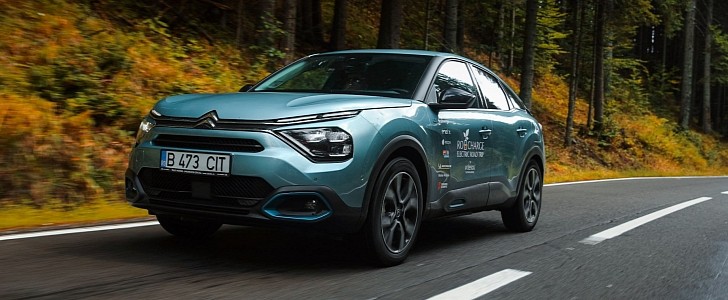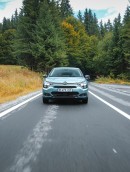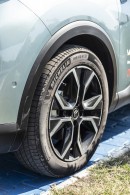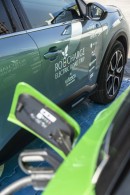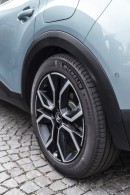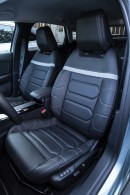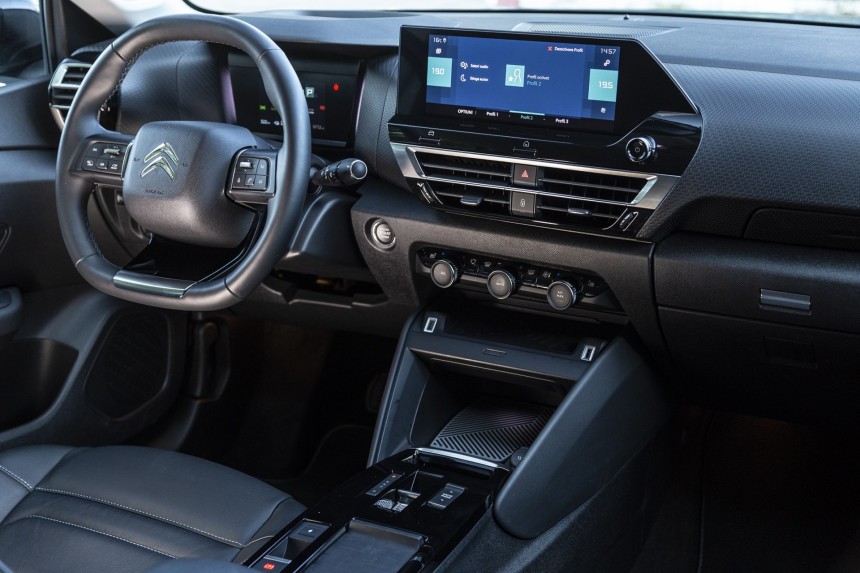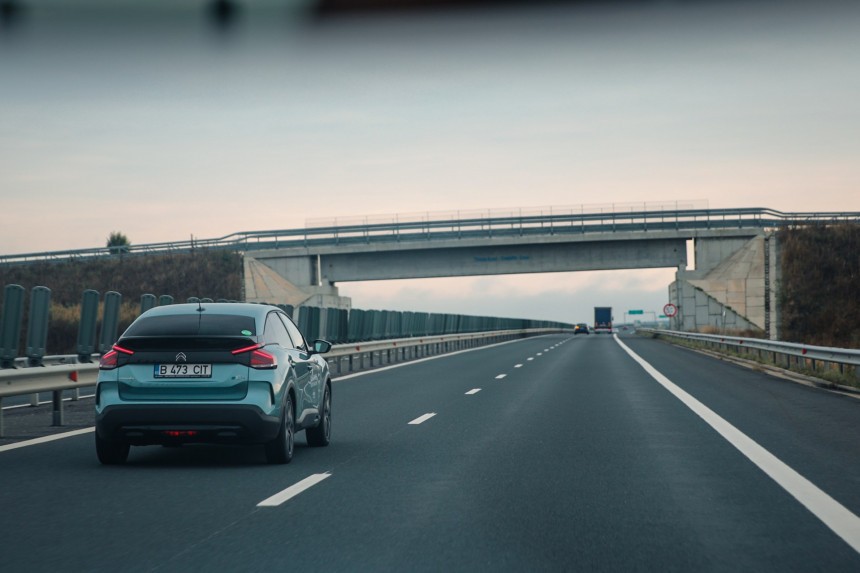Citroën, the French brand currently owned by the Stellantis corporation, has launched the second generation of its C4 compact car in an electric version as well, called the ë-C4. We drove it to see how it fares in the real world.
This is a compact-class hatchback with a body that is styled to look like it is an SUV, but the Citroën ë-C4, and the C4, for that matter, are still hatchbacks. Both the C4 and the e-C4 share their platform with the second-generation Opel Mokka.
Since both brands are owned by the Stellantis conglomerate, they received different bodies and traits to prevent them from fighting over the same customers. That is why the ë-C4 got a bigger body and a larger trunk, for example.
Citroën's ë-C4 comes with a front-wheel-drive layout, just like its internal combustion siblings. Once inside, the driver will find a fully digital gauge cluster, conventional controls for the volume and the A/C, as well as a tidy cockpit.
Citroën has implemented a tablet holder for the front passenger. The device has a tray that comes out of the dashboard, just above the glove box, and it has a dedicated tablet holder to enable entertainment on the move for the passenger.
Occupants will also discover a wireless charging tray, a USB-C port along with a regular USB port, but only the former can be used to connect the vehicle's multimedia unit to a smartphone to enable Apple CarPlay or Android Auto.
The press car that we drove came with heated and electrically operated front seats that even had a massage function. The latter is not new in the automotive world, but it is nice to see this function in this segment and at this price point. Do not expect it to be the best possible massage you could ever get, but it is something, and it can be relaxing.
From the first moment you start driving the Citroën ë-C4, you realize that the car is made to be as comfortable as possible. The steering is light and has been set up to absorb as many vibrations as possible from poor road surfaces. The suspension is also set up to be soft, so you are in for a comfortable ride.
The Citroën ë-C4 does not plan to rule drag strips, but rather satisfy the needs of its customers. So less sporty behavior in the bends, and more comfortable overall. That is why this car feels best when you stay away from the Sport mode, where the steering just gets a bit stiffer, while the accelerator does become more responsive to your input.
The result is a compact hatchback that is more appropriate for city use, but can be driven between cities if you consider its battery size. Mind you, the battery's net capacity is 46 kWh, which is more than what you would get from a Mazda MX-30, for example, and it can be charged with up to 100 kW from a DC plug.
Not all is perfect, though, as the Citroën ë-C4 does not display its battery level in percentages, like other electric vehicles. Instead, you see a gauge in the dash, just like on a conventional automobile. Unlike the BMW iX3, where adding the vehicle to your BMW Connected app will reveal the remaining battery charge numbers, Citroën's app does not do the same for the e-C4.
Oddly enough, its platform brother, the Opel Mokka-e, does show its battery charge in percentage at all times. Fortunately for those interested in numbers, the Citroën ë-C4 will show its remaining charge when plugged into a charger.
In other words, Citroën has prepared the ë-C4 for city-to-city travel, but do not expect to do it in a hurry. Mind you, the 0-100 kph (62 mph) acceleration is done in 9.7 seconds, while the top speed is electronically limited to 150 kph. Yes, that is more than what is legally allowed to drive in most countries in the world, but still, it is not that fast.
The maximum WLTP range of the Citroën ë-C4 is estimated at 352 kilometers (ca. 218 miles), and its average energy consumption is 16.0 kWh in the WLTP medium cycle. In other words, trips longer than 250 kilometers (155 miles) should involve checking the map to see where quick charging plugs are present on the route. That is not uncommon for electric vehicles, evidently, but it is the only way to get to where you need to go as fast as possible.
But how was the energy efficiency on our drive? We started with a battery that was charged at 95 percent, and the car's computer estimated that we could drive 320 kilometers (198 miles) that day. We drove 211 kilometers (131 miles) and had an average speed of 47 kph.
In other words, we kept up with traffic, stuck to the speed limit, and that was about it. No special effort was made to conserve the remaining battery charge.
The average energy consumption was 16.4 kWh/100 km (62 miles), and we had a 17 percent charge left in the battery when we arrived at our destination and plugged the car in for a refill.
We could have driven another 40 kilometers (ca. 24 miles) with the remaining charge, according to the ë-C4's estimates. Once the battery was charged back up to 100 percent, the Citroën ë-C4 estimated that we could drive 350 kilometers (217 miles) with the resulting charge.
As you can see, the figures attained in real life do not exactly add up to the official estimate, but that is alright in the end. The same thing happens to every car that is currently available on the market. The difference here is that we have a smaller battery than other EVs, but it is not that small, though.
While overall range is not this car's bragging point, it can be acquired for a competitive price in some markets, and its range should be enough for day-to-day use for the average European customer. All in all, it is not bad at all, but if you do not like it at all, it means that you must not be in the target customer base, and that is fine.
Since both brands are owned by the Stellantis conglomerate, they received different bodies and traits to prevent them from fighting over the same customers. That is why the ë-C4 got a bigger body and a larger trunk, for example.
Citroën's ë-C4 comes with a front-wheel-drive layout, just like its internal combustion siblings. Once inside, the driver will find a fully digital gauge cluster, conventional controls for the volume and the A/C, as well as a tidy cockpit.
Citroën has implemented a tablet holder for the front passenger. The device has a tray that comes out of the dashboard, just above the glove box, and it has a dedicated tablet holder to enable entertainment on the move for the passenger.
Occupants will also discover a wireless charging tray, a USB-C port along with a regular USB port, but only the former can be used to connect the vehicle's multimedia unit to a smartphone to enable Apple CarPlay or Android Auto.
The press car that we drove came with heated and electrically operated front seats that even had a massage function. The latter is not new in the automotive world, but it is nice to see this function in this segment and at this price point. Do not expect it to be the best possible massage you could ever get, but it is something, and it can be relaxing.
From the first moment you start driving the Citroën ë-C4, you realize that the car is made to be as comfortable as possible. The steering is light and has been set up to absorb as many vibrations as possible from poor road surfaces. The suspension is also set up to be soft, so you are in for a comfortable ride.
The result is a compact hatchback that is more appropriate for city use, but can be driven between cities if you consider its battery size. Mind you, the battery's net capacity is 46 kWh, which is more than what you would get from a Mazda MX-30, for example, and it can be charged with up to 100 kW from a DC plug.
Not all is perfect, though, as the Citroën ë-C4 does not display its battery level in percentages, like other electric vehicles. Instead, you see a gauge in the dash, just like on a conventional automobile. Unlike the BMW iX3, where adding the vehicle to your BMW Connected app will reveal the remaining battery charge numbers, Citroën's app does not do the same for the e-C4.
Oddly enough, its platform brother, the Opel Mokka-e, does show its battery charge in percentage at all times. Fortunately for those interested in numbers, the Citroën ë-C4 will show its remaining charge when plugged into a charger.
In other words, Citroën has prepared the ë-C4 for city-to-city travel, but do not expect to do it in a hurry. Mind you, the 0-100 kph (62 mph) acceleration is done in 9.7 seconds, while the top speed is electronically limited to 150 kph. Yes, that is more than what is legally allowed to drive in most countries in the world, but still, it is not that fast.
The maximum WLTP range of the Citroën ë-C4 is estimated at 352 kilometers (ca. 218 miles), and its average energy consumption is 16.0 kWh in the WLTP medium cycle. In other words, trips longer than 250 kilometers (155 miles) should involve checking the map to see where quick charging plugs are present on the route. That is not uncommon for electric vehicles, evidently, but it is the only way to get to where you need to go as fast as possible.
But how was the energy efficiency on our drive? We started with a battery that was charged at 95 percent, and the car's computer estimated that we could drive 320 kilometers (198 miles) that day. We drove 211 kilometers (131 miles) and had an average speed of 47 kph.
The average energy consumption was 16.4 kWh/100 km (62 miles), and we had a 17 percent charge left in the battery when we arrived at our destination and plugged the car in for a refill.
We could have driven another 40 kilometers (ca. 24 miles) with the remaining charge, according to the ë-C4's estimates. Once the battery was charged back up to 100 percent, the Citroën ë-C4 estimated that we could drive 350 kilometers (217 miles) with the resulting charge.
As you can see, the figures attained in real life do not exactly add up to the official estimate, but that is alright in the end. The same thing happens to every car that is currently available on the market. The difference here is that we have a smaller battery than other EVs, but it is not that small, though.
While overall range is not this car's bragging point, it can be acquired for a competitive price in some markets, and its range should be enough for day-to-day use for the average European customer. All in all, it is not bad at all, but if you do not like it at all, it means that you must not be in the target customer base, and that is fine.
